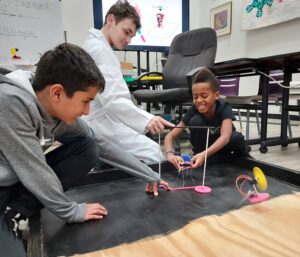 One of our recently developed STEM Scouts modules takes elementary schoolers on the journey of innovation. During their first meeting, scouts were handed individual kits and given basic instructions to assemble a simple yet entertaining wiggle bot. Wiggle bots are simple bots, that use a nonconcentric weight to generate some movement. As soon as the bots power on, typically they move in abysmal patterns, causing much amusement and giggles. The came the challenge: scouts were tasked to control their bots and make them “move in a straight line.”
One of our recently developed STEM Scouts modules takes elementary schoolers on the journey of innovation. During their first meeting, scouts were handed individual kits and given basic instructions to assemble a simple yet entertaining wiggle bot. Wiggle bots are simple bots, that use a nonconcentric weight to generate some movement. As soon as the bots power on, typically they move in abysmal patterns, causing much amusement and giggles. The came the challenge: scouts were tasked to control their bots and make them “move in a straight line.”


 This seemingly lighthearted challenge became a serious exercise in stamina and iteration for the scouts, immersing them in the hands-on intricacies of the engineering design process—a skill closely intertwined with the art of inventing.
This seemingly lighthearted challenge became a serious exercise in stamina and iteration for the scouts, immersing them in the hands-on intricacies of the engineering design process—a skill closely intertwined with the art of inventing.
Subsequent sessions delved into crucial aspects of inventing, including marketing, selling, and establishing a business. Scouts engaged in a brand awareness game, testing their knowledge of various logos. They also explored the significance of patents, examining patented products from our Council box of Inventions—among them, the crowd favorite LifeStraw. In an engaging twist, scouts were prompted to brainstorm improvements for the LifeStraw, sparking creativity and critical thinking.

A hallmark of STEM Scouts is providing career exploration; we are fortunate that this module lent well to two local field trips that enhance our STEM Scouts’ appreciation of inventing.
The National Inventors Hall of Fame museum resides in the USPTO HQ in Alexandria, VA. There scouts are able to explore exhibits such as “What is a counterfeit” and see the crowd favorite “50 years of innovation mustang”.
 The Draper Spark! Lab at the National Museum of American History offers scouts interactive exhibits to try their hand at inventing – creating circuits, constructing pinball machines, designing costumes, etc. In fact, the Spark! Lab has an excellent bite size “inventing process” that helped guide scouts through the ideating process. All scouts walked out of our third meeting with sketches and an early model of their inventions made with supplies we had in lab (clay, pipe cleaners, recyclables). A few came back to their subsequent meetings with elaborate working models! We can’t wait to see these STEM Scouts’ future as inventors!
The Draper Spark! Lab at the National Museum of American History offers scouts interactive exhibits to try their hand at inventing – creating circuits, constructing pinball machines, designing costumes, etc. In fact, the Spark! Lab has an excellent bite size “inventing process” that helped guide scouts through the ideating process. All scouts walked out of our third meeting with sketches and an early model of their inventions made with supplies we had in lab (clay, pipe cleaners, recyclables). A few came back to their subsequent meetings with elaborate working models! We can’t wait to see these STEM Scouts’ future as inventors!



